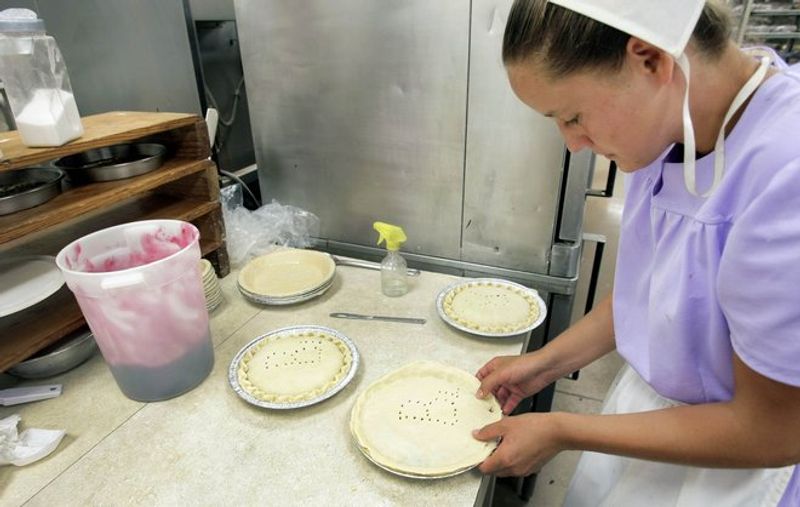Embracing traditional values and holding the flame of all-but-lost craftsmanship, the Amish and Mennonite communities continue to fascinate modern Americans (or “English” in Amish speak) with their seemingly simple, unencumbered lifestyle. Learn about the Anabaptist movement and how Oklahoma’s Amish and Mennonite communities came to settle in the Sooner State.
Anabaptist History
Both the Amish and Mennonite movements sprang from the 16th century Anabaptist movement. This offshoot of the Protestant Reformation originated in Zurich, Switzerland around 1525.
Anabaptists, whose name originated as a slur for their radical (at the time) practice of rebaptizing converts who professed their faith, came under fire from both Roman Catholic and Magisterial Protestants alike. The Anabaptists suffered horrendous persecution for their baptizing practices and close adherence to the idea that each person had the right to their own personal, literal interpretation of the Bible.
The name Mennonite originated as an insult, flung at Anabaptist followers who subscribed to the teaching of Menno Simons, a converted Roman Catholic priest and early leader in the movement. The church co-opted the term and by 1544, Dutch Anabaptists were referring to themselves as Mennonite or Mennist.
The intense persecution from mainstream religious groups drove many practitioners of the young movement out of Western Europe, with some Anabaptists/Mennonites moving to the New World. Most settled in Pennsylvania alongside similarly persecuted Quakers, while others remained in Europe, migrating east to the more tolerant plains of the Ukraine under Catherine the Great’s Russia.
As part of their literal interpretation of the Bible, specifically the Sermon on the Mount, pacifism is a cornerstone of Anabaptist doctrine. Historically, this refusal to engage in warfare has caused friction between the group and their surrounding communities. In fact, Russian Mennonites of the late 19th century fled their home of nearly four centuries, resettling in Canada and western parts of the United States rather than face forced conscription into the Tsar’s army.
From the founding of the Anabaptist movement until the middle of the 20th century, most Amish and Mennonite communities have spoken a dialect of Low German called Plautdietsch, conducting services and speaking at home in this language. Since the 1930s, as the church has modernized, Plautdietsch has been in decline among Mennonites, but among the Amish, Plautdietsch is still spoken as the primary language.
Western Oklahoma Mennonites
The first Mennonites came to Oklahoma in 1880, establishing an Arapaho mission in Darlington. Eleven other missions would follow, opening all over western Oklahoma on Cheyenne, Arapaho and eventually Comanche territory. About a decade after the first mission’s establishment, Mennonite families started to migrate to Oklahoma territory from Kansas by way of Russia, establishing a community near Hennessey in 1889.
These settlers introduced Turkey Hard Red Winter Wheat to Oklahoma. Brought from Russia, this tall, hardy cultivar had tamed the Russian Steppe and was instrumental in transforming the high plains into the bread basket of the world. As conditions became more unbearable in Russia, more Mennonite settlers came to Oklahoma and by statehood, 42 churches and communities were scattered across western Oklahoma, centered primarily around Korn (later changed to Corn), Fairview, north Enid, Meno and Goltry.
Always active in the community, the Mennonites established a school in Corn in 1902. Originally called the Washita Gemeinde Schule and later changed to Corn Bible Academy, this high school is now the oldest Christian school west of the Mississippi River. One of the ways this Mennonite school has survived over the last century is through funding received from its annual fundraiser, the German Feast & Auction. At this event, visitors can feast on traditional German food and home baked goods then enjoy a lively auction featuring everything from handmade toys to quilts.
The modern Mennonite church continues a long tradition of service with each congregation, regardless of their individual sect, pooling their efforts through the missionary arm of the church, the Mennonite Central Committee. Each November the statewide community gathers in Enid for The Oklahoma Mennonite Relief Sale, a giant fundraising effort with all proceeds benefitting this international relief and service organization. At the sale, bid on well-crafted furniture, quilts and household goods, peruse several booths featuring handmade goods and savor traditional German food and baked goods.
Amish
The Amish came into being in 1693 when their founder, Jakob Ammann, requested doctrinal clarification from the Swiss Brethren (the local Anabaptists had not yet adopted the term Mennonite). Not satisfied with the response, Amman and his followers separated, forming their own group around 1700.
Most Amish reject modern conveniences, limiting interaction with outside society while allowing a deeper focus on their spirituality. While doctrinally similar to their Anabaptist kin, the Amish tend to be a more tight-knit community with each local church district mandating what’s allowable in their individual community’s day-to-day life. For example, usage and communal placement of things like telephones, generators, solar panels or steel-wheel tractors are all decided at the local congregational level.
Chouteau Amish
While Mennonites were settling western Oklahoma and Kansas, most early Amish came during the Land Run, setting up in the eastern part of the state. Shortly after the establishment of a settlement in Mazie around 1910, an epidemic forced the small Amish community to uproot and move north to Chouteau. Since settling in, this eastern Oklahoma Amish community has thrived, growing over the last century to four church districts with around 600 people.
Embracing outsider interest in their way of life and culture, many Amish have opened businesses in Chouteau. Take a weekend trip to Chouteau and feast on German influenced Amish cuisine at Fannie’s Country Cookin’ or the Dutch Pantry.
When stopping in to the Amish Cheese House for breakfast or a lighter lunch, be sure to grab some snacks for the trip home. This giant deli and country store features a variety of bread and pastries, all made on-site at Nettie Ann’s Bakery. In addition to the baked goods, check out almost two dozen types of fudge, a large selection of canned goods, perfectly cured sandwich meats and 50 different cheeses, all either made by the Chouteau enclave or imported from one of the Ohio or Pennsylvania communities.
In early fall, the whole city of Chouteau comes together to celebrate its Amish heritage during Black Buggy Day. Attend Black Buggy Day and dine on a variety of traditional Amish and fair style food, all served up with a healthy heaping of homemade ice cream. Sip a glass of refreshing lemonade, listen to some Bluegrass and cheer on the Amish young men as they show off their horsemanship skills at this family friendly festival.
As the community has grown and flourished, other Amish owned businesses have popped up in neighboring towns. In nearby Muskogee, for example, the Amish Country Store & Restaurant offers a great place to stop in for a home cooked meal and a variety of dry goods from homemade fudge to kitchen accessories.
Clarita Amish
Smaller and younger than their neighbors to the north, the Clarita Amish community began in 1978 when a conservative group of Ohio and Indiana Amish settled in Coal County. Comprised of a single church district, this small community completely shunned modern technology until 1994 when the group voted to allow steel-wheeled tractors to help plow the high clay content Oklahoma soil.
The second Saturday in September, get up with the chickens and head to Clarita for the Amish School Auction, Crafts & Antique Show. Put on by 20 different families, this school benefit features an auction of hand-sewn quilts, antiques, glassware and crafted furniture, as well as approximately 200 different craft booths. Bring your appetite; breakfast service begins at 7am and Amish food vendors will be serving tasty treats like homemade chicken and noodles all day long.
To round out your Clarita visit, check in with the locals and find out which Saturdays the monthly auctions and markets are held during the summer. These local events feature Amish made goods, fresh produce and demonstrations. On your way out of town, stop by the Countryside Values Grocer and load the cooler up with Amish made butter and cheese, as well as canned and baked goods. Owned by an Amish family, the store also features a nice selection of hand crafted furniture.
Less than an hour south of Clarita, head to Calera and grab some free samples at Three Rivers Pecans and Amish Store. Featuring fudge and candies made with pecans harvested from the owner’s orchard, this country store also offers a large variety of homemade cheeses, butter, jellies and jams.








































